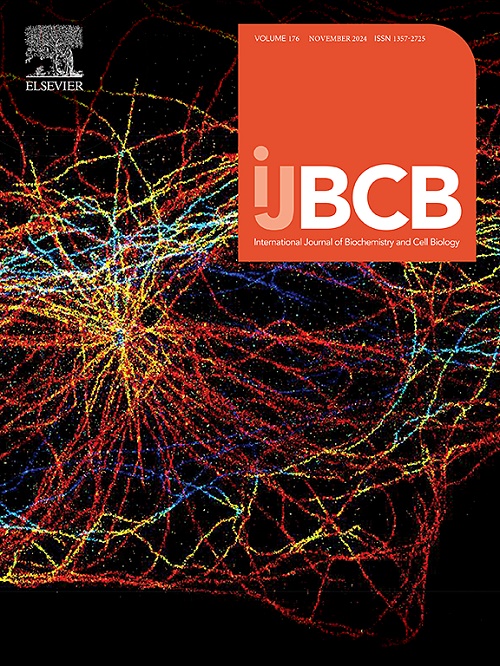通过PI3K/AKT/ mtor介导的自噬,ATP1B4作为糖尿病肌少症肌肉萎缩的候选上游调节因子
IF 2.8
3区 生物学
Q2 BIOCHEMISTRY & MOLECULAR BIOLOGY
International Journal of Biochemistry & Cell Biology
Pub Date : 2025-09-27
DOI:10.1016/j.biocel.2025.106869
引用次数: 0
摘要
目的:研究肌肉特异性基因ATP1B4在糖尿病性肌肉减少症(DS)大鼠骨骼肌代谢和线粒体自噬中的调控作用。方法:从GEO数据集GSE7014中筛选差异表达基因,确定ATP1B4为与DS相关的候选基因。采用高脂饲料喂养和注射链脲佐菌素建立DS大鼠模型。ATP1B4的表达通过慢病毒过表达或敲低来调节。此外,给予PI3K/AKT/mTOR通路激活剂(SC79、亮氨酸)和抑制剂(LY294002、MK-2206)。通过Western blotting、免疫组织化学和免疫荧光检测ATP1B4、磷酸化PI3K/AKT/mTOR组分和自噬标志物(LC3-II、DRP1、ATG9、MFN2)的蛋白表达。采用行为测试(跑步机和斜面)和组织病理学染色(H&E, Masson, PAS)评估骨骼肌功能和结构。结果:GSE7014数据集的生物信息学分析鉴定ATP1B4是骨骼肌相关的差异表达基因,富集于细胞外基质和代谢途径。在DS大鼠中,ATP1B4表达上调,同时抑制PI3K/AKT/mTOR信号传导和激活线粒体自噬标志物(LC3-II, DRP1, ATG9)。ATP1B4过表达加重了高血糖、肌肉萎缩、胶原积累和糖原沉积,而敲低则逆转了这些作用。激活PI3K/AKT/mTOR通路可改善肌肉功能和组织结构,使自噬正常化,并减少病理特征。然而,ATP1B4的共过表达消除了通路激活的保护作用。相反,ATP1B4敲低和PI3K激活的双重干预可以恢复骨骼肌的完整性和自噬通量。重要的是,ATP1B4的表达在通路调节后保持不变,支持其在DS中的单向上游调控作用。结论:ATP1B4可能作为上游PI3K/AKT/mTOR通路的抑制因子而加重糖尿病肌少症。本文章由计算机程序翻译,如有差异,请以英文原文为准。
ATP1B4 as a candidate upstream regulator of muscle atrophy in diabetic sarcopenia via PI3K/AKT/mTOR-mediated autophagy
Objective
This study aimed to elucidate the regulatory role of the muscle-specific gene ATP1B4 in skeletal muscle metabolism and mitophagy in diabetic sarcopenia (DS) rats.
Methods
Differentially expressed genes were screened from the GEO dataset GSE7014, and ATP1B4 was identified as a candidate gene associated with DS. A DS rat model was established via high-fat diet feeding and streptozotocin injection. ATP1B4 expression was modulated through lentiviral overexpression or knockdown. Additionally, PI3K/AKT/mTOR pathway activators (SC79, leucine) and inhibitors (LY294002, MK-2206) were administered. Protein expression of ATP1B4, phosphorylated PI3K/AKT/mTOR components, and autophagy markers (LC3-II, DRP1, ATG9, MFN2) was assessed via Western blotting, immunohistochemistry, and immunofluorescence. Skeletal muscle function and structure were evaluated using behavioral tests (treadmill and inclined plane) and histopathological staining (H&E, Masson, PAS).
Results
Bioinformatic analysis of the GSE7014 dataset identified ATP1B4 as a skeletal muscle-related differentially expressed gene enriched in extracellular matrix and metabolic pathways. In DS rats, ATP1B4 expression was upregulated, coinciding with suppression of PI3K/AKT/mTOR signaling and activation of mitophagy markers (LC3-II, DRP1, ATG9). Overexpression of ATP1B4 exacerbated hyperglycemia, muscle atrophy, collagen accumulation, and glycogen deposition, while knockdown reversed these effects. Activation of the PI3K/AKT/mTOR pathway improved muscle function and histological architecture, normalized autophagy, and reduced pathological features. However, co-overexpression of ATP1B4 eliminated the protective effects of pathway activation. Conversely, dual intervention with ATP1B4 knockdown and PI3K activation restored skeletal muscle integrity and autophagy flux. Importantly, ATP1B4 expression remained unchanged following pathway modulation, supporting its unidirectional upstream regulatory role in DS.
Conclusion
ATP1B4 may aggravate diabetic sarcopenia by acting as an upstream suppressor of the PI3K/AKT/mTOR pathway.
求助全文
通过发布文献求助,成功后即可免费获取论文全文。
去求助
来源期刊
CiteScore
8.10
自引率
0.00%
发文量
124
审稿时长
19 days
期刊介绍:
IJBCB publishes original research articles, invited reviews and in-focus articles in all areas of cell and molecular biology and biomedical research.
Topics of interest include, but are not limited to:
-Mechanistic studies of cells, cell organelles, sub-cellular molecular pathways and metabolism
-Novel insights into disease pathogenesis
-Nanotechnology with implication to biological and medical processes
-Genomics and bioinformatics

 求助内容:
求助内容: 应助结果提醒方式:
应助结果提醒方式:


